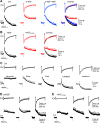This is a preprint.
NSF is required for diverse endocytic modes by promoting fusion and fission pore closure in secretory cells
- PMID: 40894625
- PMCID: PMC12393273
- DOI: 10.1101/2025.08.13.670133
NSF is required for diverse endocytic modes by promoting fusion and fission pore closure in secretory cells
Abstract
The ATPase N-ethylmaleimide-sensitive factor (NSF), known for disassembling SNARE complexes, plays key roles in neurotransmitter release, neurotransmitter (AMPA, GABA, dopamine) receptor trafficking, and synaptic plasticity, and its dysfunction or mutation is linked to neurological disorders. These roles are largely attributed to SNARE-mediated exocytosis. Here, we reveal a previously unrecognized role for NSF: mediating diverse modes of endocytosis-including slow, fast, ultrafast, overshoot, and bulk-by driving closure of both fusion and fission pores. This function was consistently observed across large calyx nerve terminals, small hippocampal boutons, and chromaffin cells using capacitance recordings, synaptopHluorin imaging, electron microscopy, and multi-color pore-closure imaging. Results were robust across four NSF inhibitors, gene knockout, knockdown, and specific mutations. These findings establish NSF as a central regulator of membrane fission, kiss-and-run fusion, endocytosis, and exo-endocytosis coupling-offering new mechanistic insights into its diverse physiological and pathological roles in synaptic transmission, receptor trafficking, and neurological diseases.
Conflict of interest statement
Declaration of interests: All authors declare no competing interests.
Figures





Similar articles
-
Prescription of Controlled Substances: Benefits and Risks.2025 Jul 6. In: StatPearls [Internet]. Treasure Island (FL): StatPearls Publishing; 2025 Jan–. 2025 Jul 6. In: StatPearls [Internet]. Treasure Island (FL): StatPearls Publishing; 2025 Jan–. PMID: 30726003 Free Books & Documents.
-
NSF binds calcium to regulate its interaction with AMPA receptor subunit GluR2.J Neurochem. 2007 Jun;101(6):1644-50. doi: 10.1111/j.1471-4159.2007.04455.x. Epub 2007 Feb 14. J Neurochem. 2007. PMID: 17302911 Free PMC article.
-
Dynamin-2 mutations linked to neonatal-onset centronuclear myopathy impair exocytosis and endocytosis in adrenal chromaffin cells.J Neurochem. 2024 Sep;168(9):3268-3283. doi: 10.1111/jnc.16194. Epub 2024 Aug 10. J Neurochem. 2024. PMID: 39126680
-
Conservative, physical and surgical interventions for managing faecal incontinence and constipation in adults with central neurological diseases.Cochrane Database Syst Rev. 2024 Oct 29;10(10):CD002115. doi: 10.1002/14651858.CD002115.pub6. Cochrane Database Syst Rev. 2024. PMID: 39470206
-
Synaptic Vesicle Recycling at the Developing Presynapse.J Neurochem. 2025 Aug;169(8):e70206. doi: 10.1111/jnc.70206. J Neurochem. 2025. PMID: 40862509 Free PMC article. Review.
References
-
- Schweizer F.E., Dresbach T., Debello W.M., O’Connor V., Augustine G.J., and Betz H. (1998). Regulation of neurotransmitter release kinetics by NSF. Science 279, 1203–1206. - PubMed
Publication types
Grants and funding
LinkOut - more resources
Full Text Sources
